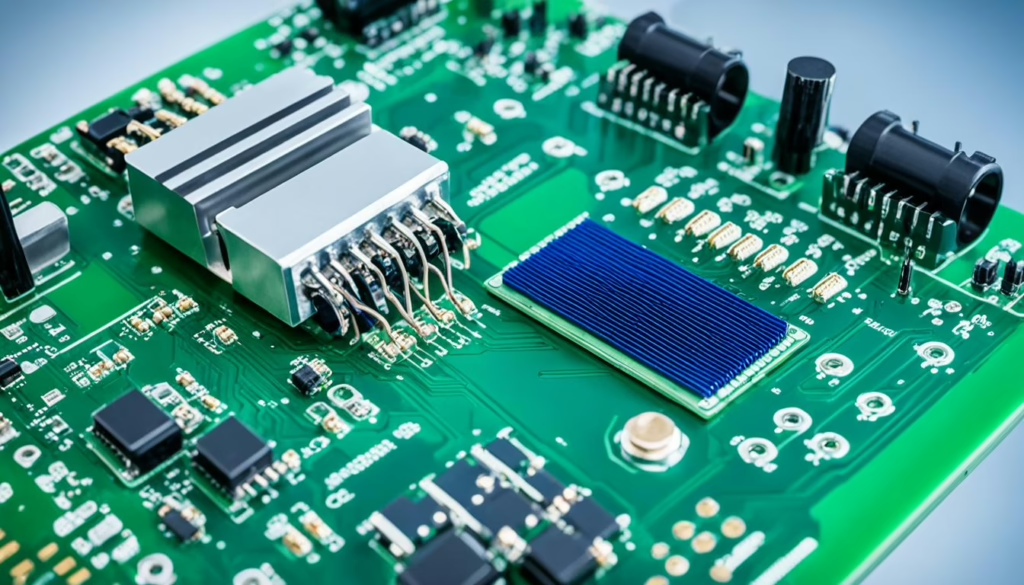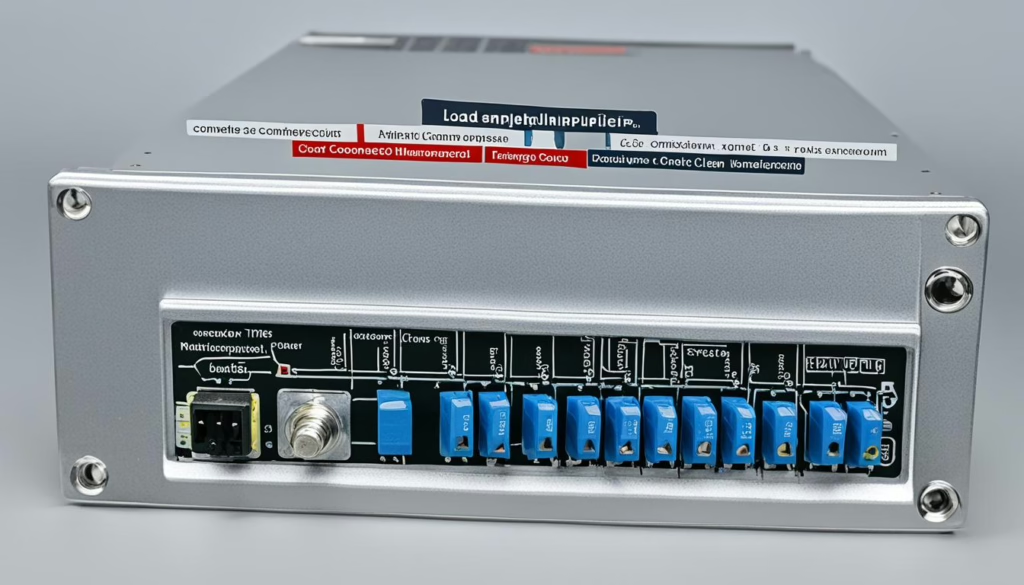A load cell amplifier is key to making sensors work better. It changes signals from load cells into something easy to read. This makes sure weight measurements are accurate. Industries like manufacturing and healthcare rely on these amplifiers a lot…
Key Takeaways
- Load cell amplifiers significantly enhance sensor performance.
- They convert signals into a readable format, ensuring precision in weight measurement.
- Vital for industries like manufacturing, logistics, and healthcare.
- They help in achieving precise measurement and operational efficiency.
- Understood as a critical component in various applications requiring accurate weight measurement.
What is a Load Cell Amplifier?
Load cell amplifiers are key in many industrial and tech fields. They boost the tiny electrical signals from load cells. This makes them easy for digital systems to read. Knowing how force transducers work and the role of load cell amplifiers is vital.
Understanding the Role of Load Cell Amplifiers
Load cell amplifiers are crucial. They turn the tiny electrical signals from load cells into strong signals for data systems. This strong signal is key for precise force measurement in science, manufacturing, and more. So, what is a load cell amplifier? It’s a device that makes sure the weak signals from load cells are strong enough to be used accurately.
Key Components and Functionality
- Strain Gauge: This is a key part that measures how much the load cell changes shape when force is applied.
- Bridge Circuit: This circuit, often a Wheatstone bridge, changes the force into an electrical signal.
- Strain Gauge Amplifier: Also known as the load cell amplifier, it makes the weak signal from the strain gauge strong enough to use.
Learning about these main parts helps clear up what is a load cell amplifier. It shows its important role in making accurate force measurements in different industries.
The Importance of Signal Conditioning
Signal conditioning is key in load cell systems. It makes sure the electrical signals from sensors are accurate and reliable. It does this by amplifying, filtering, and reducing noise.
Boosting weak signals is vital. It lets us measure tiny changes in weight. Amplifiers help by making the signals strong enough for further use. Without this, measuring weight accurately would be hard.
Reducing noise is also crucial. Electrical noise can mess up the signals from load cells, giving wrong readings. By cutting down on noise, we keep the data accurate and reliable.
Filtering gets rid of extra frequencies that mess up the signal. This makes sure only the important parts of the signal get through. With noise reduction and amplifiers, filtering makes load cell systems work better.
| Process | Function | Outcome |
|---|---|---|
| Amplification | Boosts weak signals | Measurable variations in weight |
| Noise Reduction | Minimizes electrical noise | Accurate readings |
| Filtering | Removes unwanted frequencies | Clear and precise signal |
Types of Load Cell Amplifiers
Choosing the right load cell amplifier is key. You need to know the different types and their benefits. Both analog and digital options help improve sensor performance in many applications.
Analog Load Cell Amplifiers
Analog load cell amplifiers are the traditional choice. They use the analog front-end for signal conditioning. These amplifiers are simple, reliable, and easy to use with current systems. They are perfect for industries needing consistent and precise measurements.
Digital Load Cell Amplifiers
Digital load cell amplifiers use digital signal processing for better accuracy and flexibility. They offer features like filtering, linearization, and temperature control. These capabilities make them great for working with modern control systems and data platforms.
When picking a load cell amplifier, think about what your application needs. Do you want the strength of an analog front-end or the precision of digital processing? Both types have unique benefits for different uses. This ensures you get the best performance and reliability for your measurements.
Enhancing Weight Measurement Accuracy
Getting accurate weight measurements is key in many industries. To get precise readings, we must look at how calibration and temperature affect load cells.
Calibration and Temperature Compensation
Calibration boosts the accuracy of weight measurements. It makes sure load cells give readings that match standard weights. Regular checks keep the weighing systems precise, spotting any issues early.
Temperature changes can mess with load cell readings, making them less accurate. To fix this, we use temperature compensation. This keeps the load cells working well, no matter the temperature.
Companies like Massload Technologies offer solutions for better precision. For instance, their 2-wire 4-20mA amplifier for PLC systems improves signal quality. This means accurate readings even in tough conditions.
Using strong calibration and temperature control helps businesses get better weight accuracy. This leads to smarter decisions and smoother operations.
Applications of Load Cell Amplifiers
Load cell amplifiers play a key role in many sensor applications. They are crucial in industrial weighing systems and force measurement setups. These devices make sure the signal is clear, leading to precise data in various situations.
Industrial Weighing Systems
In industrial settings, load cell amplifiers are essential for precise weight measurements. They help in everything from big manufacturing plants to logistics centers. By making sure measurements are accurate, they boost efficiency and quality.
This reliable boost in weight data helps control processes across industries.
Force Measurement and Testing
Load cell amplifiers are also vital for force measurement solutions. They work well in fast-paced testing environments. For example, in car crash tests or materials testing labs, getting accurate force data is key.
These amplifiers offer the sensitivity needed to catch small changes. They send out clear signals, which is important for detailed analysis and development.
Load Cell Amplifier
Load cell amplifiers are key to making load cell systems work better. They boost the signal to get accurate weight and force readings. This makes sure even the weakest signals from load cells are turned into clear data.
It’s important to match load cell technology with the right signal amplification for top performance. Companies like XJCSENSOR are experts in making advanced amplifiers. They work with various industries to create solutions that boost efficiency and accuracy.
The table below shows why load cell amplifiers are so effective:
| Feature | Benefit |
|---|---|
| Signal Amplification | Improves sensitivity and accuracy |
| Durability | Ensures long-term reliability in various conditions |
| Calibration | Enables precise adjustments and consistency |
| Custom Manufacturing | Provides tailored solutions for specific needs |
Load cell amplifiers are crucial for better sensor data. By working with leading sensor makers, industries can make their measurement systems more precise. This boosts their overall efficiency.
Choosing the Right Load Cell Amplifier
Choosing the right load cell amplifier is key for the best performance and compatibility with your system. You need to think about the amplifier selection criteria, performance needs, and how it matches with your load cell. These factors help you make a smart choice.
Factors to Consider
When picking the perfect load cell amplifier, focus on several important points:
- Performance Requirements: Check if the amplifier can meet your application’s needs. Does it have the right accuracy, stability, and bandwidth?
- Amplifier Selection Criteria: Decide if an analog or digital amplifier fits your system best. Think about the input range and output signal type you need.
- Load Cell Compatibility: Make sure the amplifier works well with your load cell’s signal and electrical specs. It should match your load cell’s requirements.
- Environmental Conditions: Consider the environment where the amplifier will be used. Look for one that can handle the temperature, humidity, and interference it might face.
Every application has its own needs for load cell amplifiers. It’s important to carefully plan what you need. Below is a table comparing analog and digital load cell amplifiers on key points.
| Criteria | Analog Load Cell Amplifier | Digital Load Cell Amplifier |
|---|---|---|
| Simplicity | Easy to set up but might need manual calibration | More complex but has automated calibration |
| Accuracy | Good for basic readings | Very accurate for detailed measurements |
| Output Type | Analog outputs like 4-20mA | Digital outputs and various interfaces |
| Environmental Compatibility | Can handle some environmental factors | Very resistant to environmental factors |
Troubleshooting and Maintenance
Keeping load cell systems running well means regular maintenance and quick fixes. This part talks about common issues and how to solve them. It also offers tips to keep your system in top shape.
- Inaccurate Readings
- Noise Interference
- Cable and Connection Problems
- Environmental Impacts
Here’s how to fix these problems:
- Inaccurate Readings: Make sure it’s properly calibrated and it’s within the right range. Follow maintenance best practices.
- Noise Interference: Look for electromagnetic interference (EMI) and use cables with shields.
- Cable and Connection Problems: Check cables for any damage and make sure connections are tight.
- Environmental Impacts: Keep the environment stable by controlling temperature and moisture.
Following these maintenance best practices can make your load cell systems last longer. Regular checks and early fixes stop problems before they get worse.
Here’s a quick guide to fix common load cell amplifier issues:
| Issue | Potential Cause | Solution |
|---|---|---|
| Inaccurate Readings | Improper calibration | Recalibrate the load cell |
| Noise Interference | EMI | Use shielded cables |
| Cable Problems | Damaged cables | Replace connectors/cables |
| Environmental Impact | Temperature/moisture changes | Control environment |
Integrating Load Cell Amplifiers into Data Acquisition Systems
Adding load cell amplifiers to data acquisition systems is key for accurate measurement data. It means matching the amplifier with data loggers to make a system that captures data well.
It’s important to make sure the load cell amplifier and the data acquisition system work well together. This ensures signals from the sensor get to the data logger without loss, keeping the data accurate.
There are several ways to integrate systems well:
- Direct Connection: This method makes it easy by linking the load cell amplifier straight to the data logger.
- Modular Systems: Using parts that fit together helps with flexibility and makes the system work better.
- Software Integration: Advanced software can make the amplifier and data acquisition system work together, improving data accuracy.
Knowing these methods and how they work can really boost a system’s ability to get accurate data. Each method has its own advantages, depending on what you need and the conditions of your measurements.
| Method | Benefits |
|---|---|
| Direct Connection | Simplified setup and reduced signal loss |
| Modular Systems | Flexibility in configuration and scalability |
| Software Integration | Enhanced data processing and compatibility |
It’s clear that adding load cell amplifiers to data acquisition systems is crucial. It’s essential for keeping measurement data accurate all the way through.
Conclusion
Load cell amplifiers are key to better sensor performance and accurate weight measurement. They come in analog and digital types, crucial for industries needing precise weight and force data. These devices are essential for industrial weighing, force testing, and ensuring data accuracy.
It’s important to understand signal conditioning and pick the right load cell amplifier for your needs. With the right setup, these devices boost sensor accuracy and performance. They are vital in situations where precision matters most.
Load cell amplifiers do more than just assist; they enhance measurement quality. As technology grows, their importance in industries needing precise data will increase. Using load cell amplifiers ensures your measurements are reliable, helping you work more efficiently.



